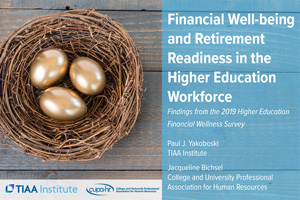How Financially Sound Are Higher Ed Workers?
 While the vast majority of full-time higher education employees are saving for retirement, there’s still room for improvement. In a session at this year’s CUPA-HR Annual Conference and Expo, Paul Yakoboski, senior economist at TIAA Institute, and Rob Shomaker, vice president and chief operating officer at CUPA-HR, shared new findings on the personal finance practices and financial wellness of full-time higher education employees.
While the vast majority of full-time higher education employees are saving for retirement, there’s still room for improvement. In a session at this year’s CUPA-HR Annual Conference and Expo, Paul Yakoboski, senior economist at TIAA Institute, and Rob Shomaker, vice president and chief operating officer at CUPA-HR, shared new findings on the personal finance practices and financial wellness of full-time higher education employees.
Key takeaways included:
- One-third of higher ed employees are dissatisfied with their financial condition, and only 16 percent are very satisfied.
- Thirty-one percent of employees are debt constrained, meaning that they have a level of debt that prevents them from adequately addressing other financial priorities. In comparison to other types of debt, student loans disproportionately increased debt constraint.
- Debt constraint is strongly associated with financial (dis)satisfaction. Employees who are not constrained by debt are 7.5 times more likely to be satisfied with their financial condition than employees who are heavily constrained by debt.
The survey also found that financial education is associated with better personal finance practices. For instance, 70 percent of employees who received financial education have a budget, but only 55 percent of employees who did not receive financial education have a budget. Additionally, employees who recently received retirement advice are more likely to be confident that they can live comfortably in retirement. The survey found that 28 percent of employees who recently received retirement advice are very confident they can live comfortably in retirement, and 13 percent of those who have not recently received such advice are very confident they can live comfortably in retirement.
What do these findings mean for higher ed? Says Yakoboski, lead author of the research report, “Colleges and universities can improve employee financial well-being by addressing concerns that stand out in the Higher Education Financial Wellness Survey — managing debt, particularly student loans; building an adequate emergency fund; and planning for when an individual is no longer saving.”
Read the full report, Financial Well-Being and Retirement Readiness in the Higher Education Workforce.


